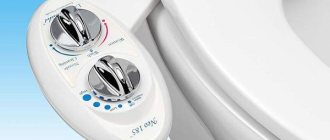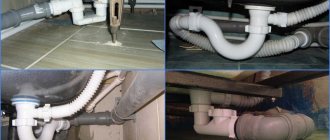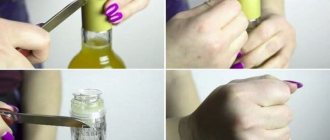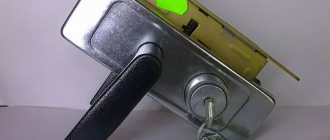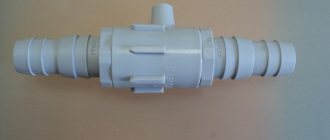How to change a siphon under a bathtub: types of equipment and self-installation
Drain and overflow are the only engineering systems used in the bathtub. They allow you to control the intake of water and can drain it if necessary or if the bath is overfilled. If you look at the old models, they consist of two elements (a siphon and an overflow), plus many different tubes that are connected to each other.
They seem to have a simple design, but at the same time complex, due to the large number of additional elements. Modern drain systems use significantly fewer parts, which greatly simplifies installation and management.
Let's look at such important questions: how to change the siphon under the bathtub, how it works, what it consists of, and what types of this device can be found.
Bath siphon device
Conclusion
If you do everything according to the instructions, then you definitely shouldn’t have any difficulties. Naturally, this statement is true if the purchased system is fully equipped. Therefore, before changing the old siphon, you need to decide on a new one. Also, cheap kits often do not include a hose and must be purchased separately.
Experts recommend using a corrugated hose in all cases, as it has a huge number of advantages. First of all, it is flexibility and ease of installation. The second thing I would like to mention is its resistance to aggressive environments (acids, alkalis, hot water, etc.). Thirdly, there is no need to adjust the length to the nearest millimeter.
Also, when purchasing, it is recommended to consult with the seller about manufacturers of drainage systems for bathtubs. The wrong choice can be made due to the large assortment. Well, if you did everything correctly, then installation will not be difficult, since any owner can do this work.
How to remove a plug from a bathroom with a modern mechanism?
Situation: there is a stopper in the bathroom, which is raised/lowered using a toggle switch (twist) under the faucet. The toggle switch (twist) stopped functioning when the plug was in the down position (plugged). It is not possible to pick up the plug. Any ideas?
You need to spin the wheel
You need to turn the wheel located on the back wall of the bathroom (which protects it from overflowing) counterclockwise. And the cork will immediately pop out on its own!
Same story, traffic jam and
Same story, the cork and the wheel do not function together, so I tied a rope to the cork and usually pulled it. But today everything went a little wrong and the plug along with the rope was sucked into the drain and a vacuum was formed. I tried to pry it off with a knife, a spatula, even a pill blister - it was no use. I don't have a plunger
Thank you very much for
Thank you very much for the tips. I was so angry, I took a bath, everything was fine, but I couldn’t unscrew the plug. A small suction cup helped, it’s good that I found it in the kitchen! The cork came out like a cute little thing!
Thank you. there is no husband,
Thank you. There is no husband, the child was bathing. The other day the plug stopped working well. and now it is completely stuck in the closed position. I scooped out the water and picked it out with a knife on the 10th attempt. but, damn it, it stopped catching the plug altogether. Thanks for your advice! I unscrewed the bolt on the plug more, voila! everything is working! and opens and closes. I'm my own plumber!
But I didn’t succeed either
But I couldn’t do it with a wood blower, or a knife, or anything. I had to consult the installer. He advised to remove the protective screen (unscrew the screws and it comes off). Then remove the plug in the siphon and pull out the plug. And when I pulled out the plug, I also pulled out a bunch of garbage underneath it! I was even surprised how much crap had accumulated there in just a year! And this plug itself broke. Now I’ll buy a regular one, with a chain, so as not to suffer!
A whole bath of water. the cork is not
A whole bath of water. the plug did not open. I didn’t drain the water, the plunger-suction cup helped... a few movements and VOILA. Thanks to the Internet. Several times already, similar sites and reviews from people have helped to cope with various problems. So write.
I live 2500 km from my parents,
I live 2500 km from my parents, my mother called that the bathtub was full and she couldn’t get the plug out. Go straight to the Internet, and that’s it. I called and told him about the plunger, two or three movements, the issue was resolved. Thank you very much.
I'm that kind of mom too. Thank you
I'm that kind of mom too. Thank you very much for writing on the Internet. I managed! Not right away, but it worked! Thank you very much!
Pour into basins, pans
Empty basins and pots with water from the bathroom and pour boiling water into it. The cork will fly out both literally and figuratively, like a scalded one.
I just took it out myself.
I just took it out myself. First, remove all the water from the bathroom. Then take a water gun (probably everyone has one lying around) and start sucking out the cork. In a second, the cork will be in your hands.
Help the girl settle scores with the drain plug
Dear forum users, who understands this matter, help me figure it out. I had a Wecost shower stall installed, with this drain plug installed in the bottom (see photo). When you press it, it closes; when you press it again, it opens. My problem is that the water drains through this plug very slowly, and it turns out that all the dirt remains in the pan.
I would like to remove this plug altogether and use a regular one with a chain. How does the plug that is currently installed work? How to dismantle it? The craftsmen who installed the booth are already gone; they can no longer be called. You need to come up with something yourself.
Of course, one can assume that in general the drainage is not organized correctly, and therefore there is no proper drainage speed, but you don’t want to immediately think about sad things. Maybe removing the plug will help at least a little. I thought I could just twist it and it would come out, but it didn’t work.
Perhaps the problem is in the design of the siphon, which is why the water does not drain well. And as you can see in the photo, the plug is normally open, the water should drain normally
Installation of heating, water supply. 8-926-582-23-72 Maximum.
Lucy wrote: just twist it and it will come out
you just need to take it out. there is a threaded pin and a wheel... unscrew the pin more... but in general I agree
maximys78 wrote: And from the photo the plug is normally open
change the siphon, it's not the traffic jam, I recommend installing Wirquin, they have a model with accelerated drainage called turbiyon. On Chinese cabins, the siphons are poor everywhere, I installed no matter how many times I installed them, I immediately recommended replacing them, and those who didn’t agree in the store agreed immediately when checking the cabin’s tightness.
Richy, thanks for the tip! If you have to change the siphon, then only with a Wirquin turbiyon!
Well, for now, I still need to remove this plug without breaking anything, and try to drain the water without it.
But, alas, sansei, I didn’t understand you clearly: “you just need to take it out. there is a threaded pin and a wheel... unscrew the larger pin...” You said that I can take it out? Taking it out means just pressing “open”? If so, then the plug does not open enough to see the pin with the wheel! And then turn the pin exactly?
Or maybe there are schematics for this device somewhere? I'm so stupid.
I apologize, it’s not quite the right train of thought, you want to pull out the plug so that the water drains better, but since the problem is not in it but in the siphon, by pulling it out you will not achieve anything, and there will be no plug. What's the point of pulling it out?
Richy, I’m not 100% sure that it’s just a matter of drainage, so I want to start by trying to do hara-kiri to the plug. Since I hope to make the hara-kiri cork myself, it will be free for me. And if this doesn’t help, then you’ll have to look for a plumber. And this will be another mess, we’ll have to take off the “skirt” at the stall, and the stall is squeezed right up to the walls of the bathroom, the “skirt” is squeezed on the sides by the walls, and in front by the washbasin on the cabinet, so it’s not a fact that we’ll remove anything at all without breaking! Secondly, the plumber will most likely be crooked, he may not only install the drain crookedly, but also what was loosened, and will leak from everywhere. This is not the first time for me to experience this, I don’t want to repeat it, as, for example, two plumbers installed one toilet for me for a month, but they didn’t install it, in fact, others came and did it. And now this toilet is swinging on its flimsy bolts in the floor, waiting for it to fall off.
So today it’s easier for me to experiment with cork, and then introduce more hemorrhagic options.
Classification
When purchasing a seemingly ordinary thing - a plug for a sink, you need to take advantage of a number of observations. They are shaped like a truncated cone, and are also made from various materials and take different sizes.
These simple devices are necessary to shut off the drainage hole, used and no longer needed, dirty running water.
Mechanical jam
It is a bathroom stopper with a chain, made of plastic, rubber or metal and coated with a thin layer of a substance that protects the product from corrosion.
Automatic plug
A more modern thing, activated by light pressure from any part of the body. This is very convenient, since you don’t have to think about how to remove the bathroom plug, because you don’t even have to bend over, making extra unnecessary movements.
Semi-automatic stopper
This bathroom drain stopper will allow you to close and open the damper using a lever, button or small handle without direct contact with the object.
Self-production
Force majeure happens when something needed at the right time is lost. In such unpleasant moments, you have to use all your ingenuity to find a way to solve the current unforeseen circumstances.
In this case, you can improvise by independently turning into reality a prototype of a universal bathroom stopper from scrap materials found in the dusty corners of the house.
Of course, for one single case you shouldn’t invent an airplane, but hastily build something similar, but you can, of course, be original by working on an entire work of art.
Temporary bushings
For one-time use, you can take a piece of foam and cut it to size. There is another technique, but it is less durable - this is a sheet of crumpled newsprint, pushed into the hole in dense layers to avoid leaks.
How to make a bathroom stopper from a piece of wood? It’s very simple, first take a ruler and measure the diameter. Then transfer the marks to the wooden beam. The next step will be cutting to the diameter and processing the material with sandpaper.
Next, all that remains is to saturate the product with a hydrophobic chemical so that it repels moisture, preventing the log from swelling.
- A beautiful lid with an unusual antique-style design will be made from wine corks connected together, but try not to leave gaps between them. This design can be covered with special glue or filled with epoxy resin - this will create an unsurpassed effect and a pleasant smooth surface.
No matter how funny it may sound, a plug made from old flip-flops will come out very airtight if you can carefully cut the rubber exactly to the shape.
What and how to make a bath stopper from
You can make more than just a temporary plug with your own hands. To do this, you do not need to purchase special materials; everything you need can be found at home or in the country. What can you use?
You can use the following:
- Tree. Simple, but not very reliable material. Without special impregnation, the wood will begin to swell.
- Silicone. This is a more reliable option, since silicone is not afraid of contact with liquids.
- Rubber. The most suitable option is that the material is flexible and does not deteriorate when exposed to water. You can use regular bottle caps.
- Flip-flop. A great option is to make a plug for the drain hole from an old slipper.
- Kids toys. Toys in the shape of a small ball are suitable.
Making a drain plug:
- Wooden. Measure the diameter of the hole for draining the water, then transfer the resulting measurement to a wooden block. Carefully cut out the cylinder and sand it using sandpaper. You can make a hole in the upper part and insert a chain or any strong cord into it. To ensure that the resulting plug serves you for a long time, cover it with several layers of special hydrophilic impregnation.
- Rubber plug. To make it, you will need several wine corks, which should be fastened together. There should be no gaps between the plugs. Otherwise, the product will begin to leak liquid.
- From a slipper. A rather labor-intensive option, because you will need to carefully cut a piece of the required diameter from the shoe. After which the circle should be sanded with sandpaper.
- Children's ball. The toy must be cut into two halves, a chain and a strong cord must be inserted. Then fill the product with silicone.
- Plastic bag. Instead of a ball, you can take a clean bag. It should also be filled with silicone, giving it the required shape. When the material is completely dry, remove it from the bag.
Important! Choose mounting silicone that is harmless to the human body.
Using these simple methods, you can make a drain plug at home. You just need to find the necessary materials and spend a little time.
Bathroom drain
Bathroom drain - what is it and what is it for? It is quite clear that the direct operation of the bath requires the mandatory removal of used and dirty water into the sewer. It is this important function that the drain structure performs, so its installation is extremely necessary immediately after installing the bowl itself.
It is impossible to drain water from the bathroom using a regular pipe or flexible hose, and not because this is a rather labor-intensive process - the use of such improvised means will not protect the room from the penetration of unpleasant odors from sewer pipes, as this will be done by a special drain. Its design has a special seal - a siphon, which prevents the penetration of sewer gases.
In addition to the siphon, the drain kit includes an overflow - a special device that allows you to drain used water through the top hole in the container. Overflow is necessary in case the bowl overflows with water and it is impossible for it to exit through the drain.
In the assortment of modern plumbing stores you can find a wide variety of types of this useful device. What types of products are there?
How to remove a metal stopper from a bathroom? How to open a bathroom drain?
The drain in the bathroom is closed with a metal stopper using a rotating handle. The handle has stopped functioning. It is impossible to pick up this plug. What to do? How to remove the plug in the bathroom if the siphon is broken?
It turned out that it was not so easy to remove the metal plug from the drain hole in the bathroom. I tried different methods, looked at the structure of this drain and the principle of its functioning, tried to carefully pry this plug somehow - as a result, I only scratched it a little, so I didn’t pry it anymore. I thought about it and decided to use a plunger; if it breaks through the blockages, then I should pull out the plug. So the plunger helped.
The drive for opening the plug is made using a cable, which can be felt from the bottom of the siphon. You need to pull the cable strongly towards yourself and the plug should come out. With such manipulation, it can break or jam later. Without the plug, you can already unscrew the siphon and replace it. You can also drill in the plug a small hole and, using some kind of hook or wire, remove the stopper completely. In this case, the siphon can be used further, with another rubber stopper.
Bath stoppers: what are they and how to choose?
join the discussion
Share with your friends
Currently, among the large number of products, it can be quite difficult to choose something good and of high quality. And even such a simple accessory as a bathroom stopper also requires a careful approach when choosing.
In specialized stores you can find any option: from a simple rubber plug to a semi-automatic one. In addition, this simple thing can give the interior a touch of romance and comfort. Manufacturers offer rubber and silicone plugs in the form of algae, flowers, rubber toys, and so on.
Choice
Varieties
- What are the types of traffic jams?
Traditionally, this is a simple plug in the shape of a truncated cone, made of plastic, brass or rubber.
A metal chain (brass or stainless steel) is attached to its eye, with which you can remove the cork without getting your hands wet. However, some fittings (the so-called set of drain fittings for a bathtub) are somewhat more complicated:
Trim - the machine allows you to open and close the drain by simply pressing it with your hand or foot;
Release of automatic strapping.
Semi-automatic piping makes it possible to open and close the outlet from the bathtub by turning the decorative handle on the overflow.
Comparison
- Which harness is more convenient and reliable?
In terms of convenience, in my opinion, the leader is the semi-automatic harness. Automatic plugs are less convenient, if only because the drain cannot be opened without getting your hand or foot wet. This is especially inconvenient when the bathtub is full of hot or ice water.
In terms of reliability, an equally undisputed leader is a harness with a separate plug on a chain. It is reliable precisely because it is extremely simple in design. Both competing solutions have their own vulnerabilities:
- For a semi-automatic plug, this is a cable connecting it to the handle on the overflow. After some time of use (usually 2-3 years), it begins to jam;
- For an automatic plug, the cause of failure is a breakdown of its fixation mechanism. It is not sold separately from the harness, which makes the maintainability of the entire structure zero.
Inexpensive and extremely reliable design.
- Which cork material is better - plastic or rubber?
Rubber. It is extremely rare for a plastic plug to seal the outlet completely hermetically. In addition, the rubber plug is easy to remove from the outlet if it gets stuck, but in the case of a plastic plug, removal sometimes results in a serious problem.
Our choice is a rubber stopper.
Varieties and their descriptions
Simple
The simplest and most cost-effective solution is a classic plug on a chain. Such products were made from rubber back in Soviet times, but then they were devoid of originality and were produced in the form of cork.
Today, manufacturers offer such options from rubber, silicone and plastic. The design of the cork is extremely simple, so it lasts for several decades. But experts recommend choosing rubber and silicone varieties for a number of reasons:
- they are more durable, do not break, do not crack;
- such a plug is easier to remove from the drain hole if it gets stuck;
- a rubber or silicone plug closes the hole more tightly and water does not pass through it;
- it is not afraid of temperature changes, it is easy to use - by installing a rubber plug, you can safely enjoy a hot bath.
Experts do not recommend purchasing plastic plugs due to their fragility and fragility. Under the influence of hot water, the plastic is deformed, which means the seal of the part is broken. In addition, if it gets stuck in the hole, it will not be easy to get it out - you will have to disassemble the drain.
Despite the simplicity of the design, today you can choose many creative and beautiful plugs, adding a touch of humor, romance and comfort to your bathroom interior.
- Variety of colors. Choose accessories of any color: classic white or black, bright pink, blue, green. The main thing is that you like it and fit the overall style of the room.
- Variety of shapes. There are plugs in the form of animals, fish, figures of men, algae, and flowers. There are works of art: prototypes of Greek statues, the Eiffel Tower, the Colosseum and the Egyptian pyramids.
- With toys on a chain: ducks, boats, fish, dogs. This option will especially delight children.
- High-tech plugs . They are equipped with a thermometer that changes color when the water temperature changes.
Best answers
My ring disappeared in the same way... The house has some kind of complex plumbing structure and even a specialist in such matters could not do anything... It was a great pity. But maybe you'll be lucky!!!
You can unscrew the pipes and get them out
Call a plumber!
Call a plumber and don't use the water yet! All is not lost yet!!
If it is gold, then it is now in the pipe (elbow), gold is heavy and sinks immediately. You can get it. My ring was lying there for almost a year, the plumber took it out)))
unscrew the pipe from below and look there)
There should be a glass (plumbing fixture) under the bath; it unwinds; if the earring is heavy, it will be in the glass
Maybe it wasn't washed down the drain? That happened to me. I decided to clean the chain with tooth powder. It flew away instantly, though into the sink. I can imagine your condition. For me, time stopped for a second. I found a wire in the toolbox, bent it with a hook... I got it. Maybe you should try this too? But what if?
I've already had enough. Suck it out of the drain with a long hose, otherwise the water there is not pleasant. Even better is a vacuum cleaner. If the earring does not retract. A small wire hook. Good luck.
Throw the second one in there so it won’t be offensive and call the plumbers to fix the pipes.
A friend of mine had a chain fall into the sink drain pipe, so she quickly turned off her water, then called a plumber, etc., the design of the sink was simple, you just had to unscrew the drain pipe and found a chain.
We suggest you familiarize yourself with Repair of washing machines the spin does not work
It was like this... I couldn’t get it
))))))))))))))). I have the same thing and it was the same, you can lift it with a knife with a thin blade, at least it worked for me)). twist and pry at the same time...
You'll have to manually rake it out as the thread breaks)))
Have you tried it with a plunger?
How about calling divers?? ? Or buying a motor pump for pumping out water?
I don’t have a screwdriver at home, should I pick up a plug???
Well, she didn’t get in there with the plug; the plug just wouldn’t open.
First, scoop out the water from the bath and drain it to reduce the pressure. Then loosen, pry, etc.
))) Scoop out the water to the bottom into the sink, using a rag or sponge to remove the remaining residue. and when it becomes free, use some thread.
there should still be a safety drain on top to prevent excess water. Eat?…
All the water into the sink and then with pressure or something sharp. and for future ones there is no need to tighten the screw on this plug all the way
It’s so good that I have a rubber stopper in my bathroom! =)
Elementary... For this operation you need an ordinary suction cup. There is another option, without a suction cup. A resourceful friend told me about him. But for this option you will have to first scoop out all the water. Turn on the vacuum cleaner, having first removed the brush and, so to speak, “suck out” the plug)))
How to remove a plug from a bathroom with a modern mechanism?
Situation: there is a stopper in the bathroom, which is raised/lowered using a toggle switch (twist) under the faucet. The toggle switch (twist) stopped functioning when the plug was in the down position (plugged). It is not possible to pick up the plug. Any ideas?
You need to spin the wheel
You need to turn the wheel located on the back wall of the bathroom (which protects it from overflowing) counterclockwise. And the cork will immediately pop out on its own!
Same story, traffic jam and
Same story, the cork and the wheel do not function together, so I tied a rope to the cork and usually pulled it. But today everything went a little wrong and the plug along with the rope was sucked into the drain and a vacuum was formed. I tried to pry it off with a knife, a spatula, even a pill blister - it was no use. I don't have a plunger
Thank you very much for
Thank you very much for the tips. I was so angry, I took a bath, everything was fine, but I couldn’t unscrew the plug. A small suction cup helped, it’s good that I found it in the kitchen! The cork came out like a cute little thing!
Thank you. there is no husband,
Thank you. There is no husband, the child was bathing. The other day the plug stopped working well. and now it is completely stuck in the closed position. I scooped out the water and picked it out with a knife on the 10th attempt. but, damn it, it stopped catching the plug altogether. Thanks for your advice! I unscrewed the bolt on the plug more, voila! everything is working! and opens and closes. I'm my own plumber!
But I didn’t succeed either
But I couldn’t do it with a wood blower, or a knife, or anything. I had to consult the installer. He advised to remove the protective screen (unscrew the screws and it comes off). Then remove the plug in the siphon and pull out the plug. And when I pulled out the plug, I also pulled out a bunch of garbage underneath it! I was even surprised how much crap had accumulated there in just a year! And this plug itself broke. Now I’ll buy a regular one, with a chain, so as not to suffer!
A whole bath of water. the cork is not
A whole bath of water. the plug did not open. I didn’t drain the water, the plunger-suction cup helped... a few movements and VOILA. Thanks to the Internet. Several times already, similar sites and reviews from people have helped to cope with various problems. So write.
I live 2500 km from my parents,
I live 2500 km from my parents, my mother called that the bathtub was full and she couldn’t get the plug out. Go straight to the Internet, and that’s it. I called and told him about the plunger, two or three movements, the issue was resolved. Thank you very much.
I'm that kind of mom too. Thank you
I'm that kind of mom too. Thank you very much for writing on the Internet. I managed! Not right away, but it worked! Thank you very much!
Pour into basins, pans
Empty basins and pots with water from the bathroom and pour boiling water into it. The cork will fly out both literally and figuratively, like a scalded one.
I just took it out myself.
I just took it out myself. First, remove all the water from the bathroom. Then take a water gun (probably everyone has one lying around) and start sucking out the cork. In a second, the cork will be in your hands.
How to open the lid on a sink? Photo
What to do? How to open the lid? I tried to hook it with something, but there were no holes.
Summary: 1. If you can’t remove it with water, then. 2. Scoop out the water. 3. Remove the siphon. 4. Push out the plug from below. 5. Let’s look at the reason for the “wedge”. 6. Eliminate. 7. Put the siphon in place. 8. tie a “tail” to the cork to remove it. You may have to drill. 9. We use it.
Best answers
Zverskaya:
))))))))))))))). I have the same thing and it was the same, you can lift it with a knife with a thin blade, at least it worked for me)). twist and pry at the same time...
Oksana Nikolaevna:
You'll have to manually rake it out as the thread breaks)))
Snezhana:
Have you tried it with a plunger?
125aaa:
How about calling divers?? ? Or buying a motor pump for pumping out water?
I don’t have a screwdriver at home, should I pick up a plug???
Daria Sorokina:
It was such crap. I loosened it with a plunger! . Then she turned the valve and helped me climb back in with my hand!
Artyom Rumyantsev:
Well, she didn’t get in there with the plug; the plug just wouldn’t open.
Irina:
First, scoop out the water from the bath and drain it to reduce the pressure. Then loosen, pry, etc.
Damir:
))) Scoop out the water to the bottom into the sink, using a rag or sponge to remove the remaining residue. and when it becomes free, use some thread.
rrr:
there should still be a safety drain on top to prevent excess water. Eat?…
Marina Kurilova:
All the water into the sink and then with pressure or something sharp. and for future ones there is no need to tighten the screw on this plug all the way
Hope:
It’s so good that I have a rubber stopper in my bathroom! =)
Sinister Copper:
Hmmm! ..to use such a bathroom... you need to take special courses... .And besides, this is further proof that the simpler the design, the more reliable it works....
Natalya Nikotina:
Elementary... For this operation you need an ordinary suction cup. There is another option, without a suction cup. A resourceful friend told me about him. But for this option you will have to first scoop out all the water. Turn on the vacuum cleaner, having first removed the brush and, so to speak, “suck out” the plug)))
Chemical removal of blockages
All chemicals for removing blockages are very popular. This is due to numerous commercials and reviews of them by other customers. According to the manufacturers themselves, their products can cope not only with blockages, but also dissolve hair, grease, lime deposits, paper and food debris. At the same time, the compositions are completely safe for both metal and plastic pipes.
Bathroom wall clock
On store shelves you can find a lot of tools for cleaning bathroom pipes.
There are several types of chemicals that can cope with the problem of how to remove a blockage in the bathroom:
- liquids;
- gels;
- powders;
- granules.
The method of using each of them is described in detail on the packaging. In most cases, it is enough to pour the contents of the bag or bottle into the drain hole and wait.
According to independent surveys, customers prefer the following brands of anti-clog products:
Mole. A well-known brand that has remained popular on the market for decades. This is a domestically produced product with an affordable price. On average, 1 liter of Mole costs about 50-60 rubles. The composition includes: potassium and sodium hydroxide, surfactants, acetic acid. To use, you need to pour Mole into the drain hole and leave it to act for a period of 1.5 to 3 hours. After opening the tap, rinse the pipe thoroughly. According to the manufacturer, one time is enough to completely remove the blockage;
Chirton (Clean drains) is an English-made product, available only in granular form and, according to many users, has an optimal price-quality ratio. You can buy Chirton for 20 rubles, the same price as the smallest package of 20 g. It contains caustic soda and sodium hydroxide
When using Chirton, special attention is paid to safety: alkali, when reacting, can release toxic gases. Therefore, all actions are carried out with gloves, and there must be a constant flow of fresh air into the room.
The product performs its functions equally well in both hot and cold water; Bagi Pothan. The drug is produced in Israel and has the strongest formula that allows you to eliminate any blockage. The cost for a 600 gram package varies from 350 to 450 rubles. Bagi contains: surfactants, concentrated alkali, acids of inorganic origin. Thanks to this aggressive composition, the product dissolves hair, paper and food waste in a few minutes. When operating Bagi Pothan, the use of gloves is a must. After completion of work, the room must be well ventilated; Tiret. The drug is available in the form of a gel. This domestic product is actively advertised in various media and is popular among consumers. The price of one liter of Tiret is approximately 400 rubles. The composition indicated on the bottle includes: active chlorine, surfactant. The one liter volume is designed for 4-6 applications, depending on the severity of the blockage. The gel must be poured into the drain hole and left to work for 5-10 minutes. Then, rinse the pipe with hot water. As with other chemicals, you need to wear gloves when working with Tiret; Sanfor is another Russian-made brand. This manufacturer not only has products for removing blockages, but also other cleaning compounds. In this case, the composition contains sodium hydrochloride and hydroxide, active salts and various surfactants. For a bottle of 750 g you will have to pay from 60 to 80 rubles. Sanfor is fast-acting (only 10-15 minutes) and effective, removing hair, grease and other contaminants. At the same time, no special protective equipment is required; Deboucher Aqualon is a domestic product, costing from 120 rubles per liter. Deboucher contains: sodium and potassium hydroxides, catalysts and chlorine. The period of exposure to the blockage is from 1 to 2 hours, after which the pipe is washed with hot water. A significant disadvantage is high consumption. One package is enough for only a few uses, and sometimes even one time.
Temporary covers
But there is an option to spend a little more time to try to create a more durable option.
How to make a bathroom stopper from a piece of wood? It’s very simple, first take a ruler and measure the diameter. Then transfer the marks to the wooden beam. The next step will be cutting to the diameter and processing the material with sandpaper.
Next, all that remains is to saturate the product with a hydrophobic chemical so that it repels moisture, preventing the log from swelling.
A beautiful lid with an unusual antique-style design will be made from wine corks connected together, but try not to leave gaps between them. This design can be covered with special glue or filled with epoxy resin - this will create an unsurpassed effect and a pleasant smooth surface.
No matter how funny it may sound, a plug made from old flip-flops will come out very airtight if you can carefully cut the rubber exactly to the shape.
For a temporary jam you can use:
- A piece of foam, cut to fit the drain hole.
- The fastest, but also the most short-lived way to make a bathroom stopper is to crumple up a newspaper or sheet of paper. You just need to push the paper very tightly so that the homemade plug lasts longer.
- You can make the method a little more complicated: stuff the paper tightly, giving it the desired shape, then dry it, and then tie the bags, removing air from them as much as possible.
- For a while, you can plug the hole with whatever you have on hand, for example, a sock or even several if one is not enough. Simply scrunch one or more socks into a ball and stuff them into the hole.
- You can fill a sock with fine salt or sand and wrap it in a plastic bag on top. Pour the filling into the sock in a small amount. Thanks to them, the sock will take the desired shape and reliably hold water in the bath.
- If you have foil on hand, crumple it into a ball and cover the drain hole with this ball. The size of the ball should be slightly larger than the hole in the shell itself. This lid holds water well, but it is disposable.
We suggest you familiarize yourself with How to make a sewer cover with your own hands
Important! You should not use this method regularly, it will cost you more than just buying a new plug
- You can fit any children's toys of a suitable size under the cover. But, of course, they must be made of material that does not allow water to pass through. For example, it could be a ball of suitable diameter.
- Wrinkle a sponge for washing dishes, put it in a bag and insert it into the drain hole - the temporary plug is ready.
- Cover the outlet with a plastic cup or a wet rag folded several times.
What can you use for a bath instead of a cork?
So, you decided to take a bath and discovered that the drain plug was missing. To cope with this annoying situation, use the means at hand. So, you may find it useful:
- Plastic bag. It must be clean. You need to put a small piece of fabric in the bag. Please note that the size of the fabric should only be slightly larger than the diameter of the water drain hole. The flap must be folded several times and placed inside polyethylene. The bag should be tightly tied and placed in the drain. When you start drawing water, the improvised plug will be sucked in and the water will not flow out.
- Foil. A piece of foil needs to be folded several times and plugged into the drain.
- Cup. You will need a plastic cup as the glass product may break. The glass must be installed in the hole, placing it upside down.
- Styrofoam. You should cut a piece exactly the size of the drain.
- Sock. The fastest and easiest way. Take one or more socks, scrunch them up, and plug the drain. You can also pour a small amount of sand into a sock and wrap it in plastic.
- Sponge for washing dishes. Fold it so that it fits into the drain, then wrap it in cellophane - the plug is ready.
- Newspaper, paper sheet. The option is fast, but short-lived. You will need newspaper or sheets of paper. Fold them tightly several times and place them in the water outlet.
Installation Tips
Experts note that anyone can install a bottom valve with their own hands, since the device has a very simple configuration. But it should be taken into account that most often, the process of installing this useful accessory involves work on fastening the mixer itself. Therefore, the process of completing this task is a complex and multi-stage event.
Craftsmen advise paying attention to the fact that the decorative coating of plumbing products is very easy to spoil, so during work, you should not use a tool with different teeth. It would be useful to protect your work with gaskets; products made of copper and brass are available for sale
Having finished installing the mixer, you need to start installing the bottom valve.
The technology for performing this process can be divided into the following stages:
- The valve itself is inserted into the drain hole of a sink, washbasin or any other fixture.
- The spokes need to cross each other, and the place where they meet is securely secured with a plastic cross.
- Next, the spokes must be connected to the adjustment lever and the eye of the plug itself. It is this design that ensures the opening and closing of the hole in the plumbing bowl.
When purchasing a bottom valve, you should also take into account the configuration of the plumbing fixture where the plug will be installed, since sinks and washbasins come with or without a water overflow. The valve model that should be purchased depends on this design feature.
How to open a stopper in a sink
You can install any valve yourself. Installation of a mechanical valve is as simple as possible. The valve itself is inserted into the drain hole and fixed. A spoke is connected to the lever and the valve ear; it is responsible for opening and closing the plug.
After installation, the siphon is connected. The functionality of the valve and the presence of leaks are checked. If the device operates and there are no leaks, the valve is ready for use.
Automatic bottom valve (installation)
There are faucets with an automatic valve, equipped with and without an overflow. Let's consider their installation. Before installation, it is worth checking the length of the pipes (they can be rigid and must be shortened)
When reducing the length of the pipes, be sure to rinse the unit under running water in all directions for 3-5 minutes. This will help to avoid operational disruptions. It is better to place the mixer on a sealant, which will increase the quality of fit and service life.
The valve is installed in the sink hole. The lever mechanism itself is immersed along with the mixer. After fixing, we connect all the tubes and hoses under the sink.
A water seal (bottle or tubular siphon) is placed in the drain, and the valve spokes are folded into the shape of an equilateral cross. They are fastened with a self-tapping screw in a cross-shaped form made of plastic. The ends of the spokes are connected according to the scheme: with a lever on one side and with a valve loop on the other.
Vertical forward movements will provide a future mechanism for draining water when the lever is pressed. If there is an overflow system, don’t forget to connect it. We connect the lever of the mechanism to the valve and attach the siphon. We check for leaks.
In case of no result. We advise you to go through the system and install it again. In rare cases, a manufacturing defect may occur. Faucets equipped with a valve without overflow are installed in the same way.
Installing an automatic valve to an existing faucet
There are bottom valves for faucets (such faucets have a hole for the lever). If there is none. The installation task is more difficult, but doable. To do this you will need a hole for a lever or button. If the sink is metal, you can make a hole yourself. And install the valve according to the instructions.
A mechanical valve is suitable for a washbasin. The automatic valve is ideal for the kitchen. Immersing your hands in dirty, greasy water is unpleasant.
Pay attention to the tools; it’s good if they don’t have sharp corners. Line the sink with cardboard or other material before installation to avoid damage.
Gaskets occupy a special place during installation; do not forget about them. Tighten all nuts and bolts tightly.
Types of foot valves
The bottom valve for a sink is an analogue of a rubber stopper. The difference between them is not only in aesthetics and hygiene.
The bottom valve operates by pressing a button. This device is designed to hold water in the sink, which saves water and therefore money.
There are the following types of bottom valves:
- Mechanical
- Automatic
- With overflow
- No overflow
The basis of the mechanism is a spring!
- Easy to install
- Long service life
- Loyal price
Automatic foot valves
The disadvantage is that to drain it you will need to put your hand in the water.
Automatic ones close and open using a lever (button) The entire mechanism is located under the sink, which preserves the appearance of the faucet. The lever (button) itself is in most cases located at the back of the tap.
- The aesthetic appearance of the sink is preserved
- Installation is not difficult
- Maintaining hygiene
Automatic valves come in two types, with and without overflow. Valves with overflow have an outlet, like in a bathroom, to prevent the sink from overflowing with water. Valves without overflow are not equipped with this outlet.
If the washbasin or sink does not have an overflow hole, then it is logical to install a valve without this function. The valves are available in three versions. In gold, bronze and chromed metal. Which one to choose is up to you.
The stopper in the bathroom is leaking water
› Foundation
02.01.2020
What kind of bathtub plugs can you find on sale? Which ones are the most convenient and reliable? Finally, how can you plug a bathtub if there is no stopper? I am going to answer these and some other questions in my article.
Unusual stopper with a float.
Varieties
Traditionally, this is a simple plug in the shape of a truncated cone, made of plastic, brass or rubber.
Brass plugs were used to complete cast iron bathtub fittings that were produced more than three decades ago. Nowadays they are found only in apartments of old houses, in which the plumbing has not changed during the entire period of their operation.
A metal chain (brass or stainless steel) is attached to its eye, with which you can remove the cork without getting your hands wet. However, some fittings (the so-called set of drain fittings for a bathtub) are somewhat more complicated:
Trim - the machine allows you to open and close the drain by simply pressing it with your hand or foot;
Release of automatic strapping.
Semi-automatic piping makes it possible to open and close the outlet from the bathtub by turning the decorative handle on the overflow.
- Which harness is more convenient and reliable?
In terms of convenience, in my opinion, the leader is the semi-automatic harness. Automatic plugs are less convenient, if only because the drain cannot be opened without getting your hand or foot wet. This is especially inconvenient when the bathtub is full of hot or ice water.
In terms of reliability, an equally undisputed leader is a harness with a separate plug on a chain. It is reliable precisely because it is extremely simple in design. Both competing solutions have their own vulnerabilities:
- For a semi-automatic plug, this is a cable connecting it to the handle on the overflow. After some time of use (usually 2-3 years), it begins to jam;
- For an automatic plug, the cause of failure is a breakdown of its fixation mechanism. It is not sold separately from the harness, which makes the maintainability of the entire structure zero.
The price of a plastic harness with a separate plug usually does not exceed 350 - 400 rubles. Metal strapping - a semi-automatic machine will cost the buyer at least 1,500.
Inexpensive and extremely reliable design.
- Which cork material is better - plastic or rubber?
Rubber. It is extremely rare for a plastic plug to seal the outlet completely hermetically. In addition, the rubber plug is easy to remove from the outlet if it gets stuck, but in the case of a plastic plug, removal sometimes results in a serious problem.
Our choice is a rubber stopper.
- How to remove the plug from the bathtub if it is tightly stuck in the outlet?
It all depends on its material and design.
The easiest way to do this is with a rubber plug: you just need to pick it up by the edge with a flat-head screwdriver.
This also applies to a metal plug with a rubber shell.
You can try to remove the plastic plug with the same screwdriver, alternately prying it from different sides.
If this does not help, a corkscrew for wine bottles can often save the situation: it is screwed into the cork, after which it is removed with some effort. Of course, after this you will need to go to the store to get a replacement for the damaged part.
Finally, if the corkscrew turns out to be powerless, you have to take radical measures: the cork is drilled in the middle and removed with pliers.
The biggest problem that can cause the owner is a brass plug stuck in the outlet of an old bathtub. Especially if the eye for the chain, which can be caught with pliers, is broken off. Sometimes it is possible to grab its edge with a gas wrench. If the key slips, you have to disassemble the outlet and knock out the plug from below, which is extremely inconvenient due to the tightness under the bathtub.
The worst case scenario is dismantling the cast iron outlet. In this case, it is easier to change the entire harness.
As a rule, cast iron trims are equipped with brass plugs. Here are some recommendations for dismantling them:
- First, disconnect the outlet from the tubular siphon by unscrewing the union nut on the connection. This can be done with a gas wrench No. 3 - No. 4;
- Try to unscrew the outlet by inserting open pliers into its grille. If necessary, use any lever inserted between their handles;
- If the outlet does not work, heat it from below with a hair dryer or blowtorch. Thermal expansion will do its job, and the thread will move.
The bathtub plug is stuck tightly, how to remove the plug stuck in the drain from the bathtub?
The plug was stuck tightly, they pulled and broke the chain, how to remove a stuck plug from a bathroom drain.
Most likely your plug is made of soft rubber or silicone, or whatever they are made of in the modern world, I once had such a problem.
We bought a new plug, when I put it in the siphon, I was also surprised why it somehow sat there freely, rising and falling without any effort. But having filled the bathtub with water, it fulfilled its function; nothing was drained. The water was not cold, I got it for the child, it was even a little bitter, because I wanted the bath to warm up before swimming.
In short, the child was bathed, then the wife took a bath, and then I came and, as in your description, I pulled the chain weakly at first, the cork did not give in, and when I pulled harder, the lower ring of the chain bent. The chain is in your hands, the stopper is in the siphon and there is a full bath of water.
It was not very convenient to poke around in the water, so I had to take a screwdriver and after several unsuccessful attempts with a torn eye under the chain, I finally pulled out the plug.
After the water had drained, I tried to plug the drain hole with a plug and realized that it closed it very tightly. Subsequently, he determined that when the plug gets into warm water, it expands and gets tightly stuck in the siphon.
I don’t know whether this is good or bad, on the one hand, not a drop is drained into the sewer, as often happens, you pour a full bath of water, and after 15 minutes there’s already half there. But on the other hand, this plug did not last long; I still tore it with a screwdriver the next time I took it out.
I advise you not to fall for all sorts of silicone plugs, but to buy a regular one made of rubber with a durable eyelet.
Source
The plug is stuck in the sink.
It spins around its diameter, how can I explain it more clearly? You press on one edge, it goes down, and on the opposite edge it goes up. The same one is in the bathroom stall. Just in case, I pulled it out completely until it got stuck. It itself is metal, and on the side along the entire circumference there is a rubber donut, which holds the water horizontally when the plug is closed. So, the answer to this question was that you just need to twist it counterclockwise and it will come out. Nothing like that, it just spins and that’s it, it doesn’t come out. I checked the plug in the shower stall. What to do, drill a hole in it and pull it out? Help, good people.
Vote for best answer
eee... I don't know what yours is... We have a pimp on the tap, you press it and the plug comes out. and then you can calmly take it and pull it out. O_o...


